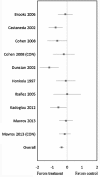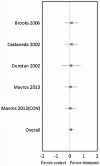Resistance Training for Glycemic Control, Muscular Strength, and Lean Body Mass in Old Type 2 Diabetic Patients: A Meta-Analysis
- PMID: 28382531
- PMCID: PMC5446383
- DOI: 10.1007/s13300-017-0258-3
Resistance Training for Glycemic Control, Muscular Strength, and Lean Body Mass in Old Type 2 Diabetic Patients: A Meta-Analysis
Abstract
Introduction: Type 2 diabetes (T2D) in elderly patients is associated with accelerated loss of skeletal muscle mass and strength. However, there are few meta-analysis reviews which investigate the effects of resistance training (RT) on glycemic control and skeletal muscle in the patients.
Methods: Three electronic databases were searched (from the earliest date available to November 2016). Studies were included according to the inclusion criteria: T2D patients at least 60 years old, fasting plasma glucose of at least 7.0, and at least 8 weeks of RT.
Results: Fifteen cohorts of eight studies (360 patients, average age 66 years) met the inclusion criteria. RT groups lowered glycosylated hemoglobin (HbA1c) (mean ES = -0.37, 95% CI = -0.55 to -0.20, P < 0.01) but did not result in a significant effect on lean body mass (LBM) (mean ES = 0.08, 95% CI = -0.15 to 0.30, P = 0.50). Homogeneity was shown between studies regarding HbA1c and LBM (Q = 15.70, df = 9, P = 0.07 and Q = 0.12, df = 4, P = 0.998, respectively). High-intensity subgroups showed a slight tendency to improve (rather than duration, frequency, and weekly volume) and to decrease HbA1c levels more than low-intensity subgroups (P = 0.37). RT increased muscular strength (mean ES = 1.05, 95% CI = 0.26-1.84, P = 0.01). No training components explained the heterogeneity between studies with changes in muscle strength.
Conclusion: RT improves glycemic control and muscle strength in elderly patients with T2D. RT with high intensity can be a strategy to treat patients with T2D and sarcopenia associated with aging.
Keywords: Aging; Glycosylated hemoglobin; Insulin sensitivity; Sarcopenia.
Figures



References
-
- American Diabetes Association. National Diabetes Statistics Report Estimates of diabetes and its burden in the epidemiologic estimation methods. Natl Diabetes Stat Rep. 2014;2014:2009–2012.
-
- Coon PJ, Rogus EM, Drinkwater D, Muller DC, Goldberg AP. Role of body fat distribution in the decline in insulin sensitivity and glucose tolerance with age. J Clin Endocrinol Metab. 1992;75(4):1125–1132. - PubMed
Publication types
LinkOut - more resources
Full Text Sources
Other Literature Sources
Medical
Miscellaneous

